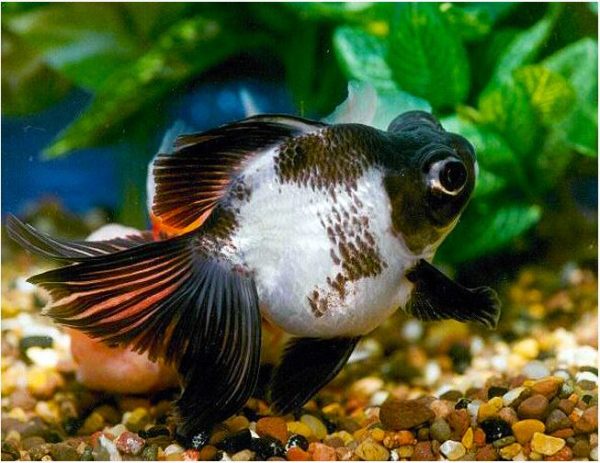


Their eyes cause them to have poor vision, so they are not a good competitor for food. This is not because they lack general hardiness, but because of their extremely telescopic eyes. Like the Black Moor, the Telescope Goldfish can live at colder temperatures, but unlike the Black Moor, the Telescope are not considered good beginner fish. The well known and very popular Black Moor Goldfish is basically a black version of the Telescope Goldfish, though its eyes don't protrude quite as far. The bi-colored black/white version is affectionately known as the Panda Telescope Goldfish, and one unique chocolate version has orange pompoms. These include solids of red, blue, chocolate, or white tri-colored and calico and bi-colored versions in red/white and black/white. The Telescope Goldfish is available in many different colors in both metallic and nacreous scale types, but seldom in a matte scale type. Today, they are also available with long flowing fins and a couple other tail fin styles: veil tail, broadtail, and butterfly tail. The body is short and stubby with a very wide head and a split caudal (tail) fin that is moderate in length and slightly forked. It is very similar to the Fantail Goldfish except for its telescoping eyes and slightly smaller size. The Telescope Goldfish is one of the more rounded or egg-shaped fancy goldfish. Later in that century, in Japan, they were given the name Demekin, which the Japanese still call them today.

The Telescope Goldfish are believed to have been first developed in China in the early 1700s when they were named the Dragon Eye Goldfish or Dragonfish. On some individuals, these stalks can extend out as far as 3/4 of an inch (19 - 20 cm), but they don't really start to protrude until these fish are about 6 months old. Their large eyes are set on top of long telescope or cone-like stalks mounted on the sides of its head. The Atlantic.The eyes are the most curious characteristic of the Telescope Goldfish. How salmon switch on infrared vision when swimming upstream. Protecting your eyes from the Sun's UV light. What is light? The visible spectrum and beyond. Sensitivity differences in fish offer near-infrared vision as an adaptable evolutionary trait. Shcherbakov, D., Knörzer, A., Espenhahn, S., Hilbig, R., Haas, U., & Blum, M. The ontogeny of ultraviolet sensitivity, cone disappearance and regeneration in the sockeye salmon Oncorhynchus nerka. Tetrachromatic color vision in the goldfish becomes trichromatic under white adaptation light of moderate intensity. National Aeronautics and Space Administration, Science Mission Directorate. The eyes of the common carp and Nile tilapia are sensitive to near-infrared. Zebrafish larvae show negative phototaxis to near-infrared light. Hartmann, S., Vogt, R., Kunze, J., Rauschert, A., Kuhnert, K.-D., Wanzenböck, J., Lamatsch, D. The visual system of zebrafish and its use to model human ocular Diseases. Proceedings of the National Academy of Sciences, 107(13), 6034–6039. Electroretinographic analysis of ultraviolet sensitivity in juvenile and adult goldfish retinas. Ultraviolet-sensitive cones in the goldfish. Ultraviolet receptors, tetrachromatic colour vision and retinal mosaics in the brown trout (Salmo trutta): Age-dependent changes.


 0 kommentar(er)
0 kommentar(er)
